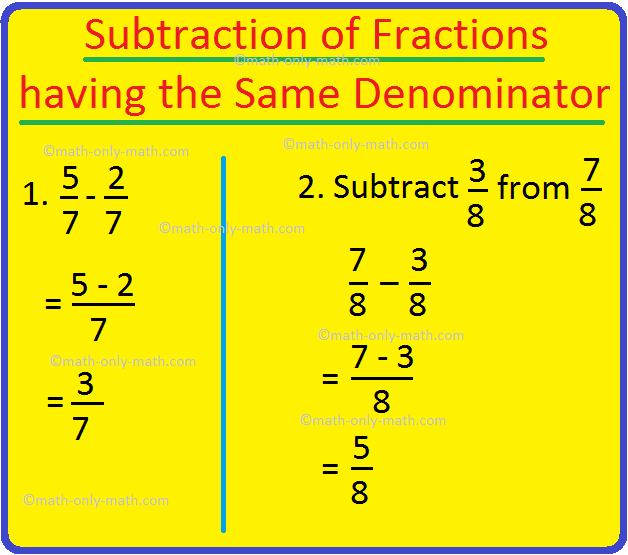Subscribe to our ▶️ YouTube channel 🔴 for the latest videos, updates, and tips.
Subtraction of Fractions having the Same Denominator
In subtraction of fractions having the same denominator, we just need to subtract the numerators of the fractions.
To find the difference between like fractions we subtract the smaller numerator from the greater numerator. The denominator of the required fraction is the common denominator of the given fractions.
Difference of two fractions with like denominators = \(\frac{\textrm{Difference of Numerators}}{\textrm{Common Denominator}}\)
For example:
\(\frac{5}{7}\) - \(\frac{2}{7}\) = \(\frac{5 - 2}{7}\) = \(\frac{3}{7}\)
Follow the steps of subtraction of like fractions:
We can subtract in a similar way. 7/8 of the class are boys.
3/8 of the class are girls. By how much fraction are the boys more?
Boys 7/8
Girls 3/8
7/8 - 3/8
= (7 - 3)/8
= 4/8
The difference is 4/8 or 1/2
We can also reduce the fraction to the lowest term.
4/8 ÷ 4/4
= 1/2
Examples of subtracting fractions with the same denominator:
1. Subtract 3/8 from 7/8
Solution:
7/8 – 3/8
= (7 - 3)/8

= 1/2
2. Subtract 5/6 from 11/6
Solution:
11/6 – 5/6
= (11 - 5)/6
= 6/6
= 1/1
= 1
3. Subtract 7/9 from 11/9
Solution:
11/9 – 7/9
= (11 - 7)/9
= 4/9
4. Subtract 4/6 from 16/6
Solution:
16/6 – 4/6
= (16 - 4)/6

= 2/1
= 2
5. Subtract 2/4 from 17/4
Solution:
17/4 – 2/4
= (17 - 2)/4
= 15/4
Subtraction of Like Fractions:
6. Subtract \(\frac{7}{17}\) - \(\frac{5}{17}\)
\(\frac{7}{17}\) - \(\frac{5}{17}\) = \(\frac{7 - 5}{17}\)
= \(\frac{2}{17}\)
7. Subtract \(\frac{13}{23}\) - \(\frac{9}{23}\)
\(\frac{13}{23}\) - \(\frac{9}{23}\) = \(\frac{13 - 9}{23}\)
= \(\frac{4}{23}\)
Subtraction of Fractions with the Same (Like) Denominator
To subtract fractions with like denominator, we subtract the smaller numerator from the greater to obtain the numerator of the required fraction.
8. Subtract \(\frac{3}{8}\) from \(\frac{9}{8}\)
Solution:
\(\frac{9}{8}\) + \(\frac{3}{8}\)
= \(\frac{9 - 3}{8}\)
= \(\frac{6}{8}\)
9. Subtract \(\frac{5}{14}\) from \(\frac{9}{14}\)
Solution:
\(\frac{9}{14}\) - \(\frac{5}{14}\)
= \(\frac{9 - 5}{14}\)
= \(\frac{4}{14}\)
Worksheet on Like Fraction:
1. Subtract the following Like Fractions:
(i) \(\frac{12}{17}\) - \(\frac{5}{17}\)
(ii) \(\frac{17}{23}\) - \(\frac{4}{23}\)
(iii) \(\frac{9}{13}\) - \(\frac{3}{13}\)
(iv) \(\frac{3}{11}\) - \(\frac{2}{11}\)
(v) \(\frac{5}{17}\) - \(\frac{2}{17}\)
(vi) \(\frac{11}{16}\) - \(\frac{7}{16}\)
(vii) \(\frac{9}{24}\) - \(\frac{5}{24}\)
(viii) \(\frac{15}{24}\) - \(\frac{14}{24}\)
(ix) \(\frac{7}{12}\) - \(\frac{4}{12}\)
(x) \(\frac{8}{16}\) - \(\frac{5}{16}\)
(xi) \(\frac{9}{14}\) - \(\frac{5}{14}\)
(xii)\(\frac{8}{18}\) - \(\frac{5}{18}\)
Answer:
1. (i) \(\frac{7}{17}\)
(ii) \(\frac{13}{23}\)
(iii) \(\frac{6}{13}\)
(iv) \(\frac{1}{11}\)
(v) \(\frac{3}{17}\)
(vi) \(\frac{4}{16}\)
(vii) \(\frac{4}{24}\)
(viii) \(\frac{1}{24}\)
(ix) \(\frac{3}{12}\)
(x) \(\frac{3}{16}\)
(xi) \(\frac{4}{14}\)
(xii)\(\frac{3}{18}\)
2. Fill in the blanks:
(i) \(\frac{8}{21}\) - \(\frac{3}{---}\) = \(\frac{5}{21}\)
(ii) \(\frac{5}{7}\) - \(\frac{---}{7}\) = \(\frac{1}{7}\)
(iii) \(\frac{5}{19}\) - \(\frac{3}{19}\) = \(\frac{2}{---}\)
(iv) \(\frac{9}{16}\) - \(\frac{7}{---}\) = \(\frac{2}{16}\)
Answer:
2. (i) 21
(ii) 4
(iii) 19
(iv) 16
● Related Concepts
- Fraction of a Whole Numbers
- Representation of a Fraction
- Equivalent Fractions
- Properties of Equivalent Fractions
- Finding Equivalent Fractions
- Reducing the Equivalent Fractions
- Verification of Equivalent Fractions
- Finding a Fraction of a Whole Number
- Like and Unlike Fractions
- Comparison of Like Fractions
- Comparison of Fractions having the same Numerator
- Comparison of Unlike Fractions
- Fractions in Ascending Order
- Fractions in Descending Order
- Types of Fractions
- Changing Fractions
- Conversion of Fractions into Fractions having Same Denominator
- Conversion of a Fraction into its Smallest and Simplest Form
- Addition of Fractions having the Same Denominator
- Addition of Unlike Fractions
- Addition of Mixed Fractions
- Word Problems on Addition of Mixed Fractions
- Worksheet on Word Problems on Addition of Mixed Fractions
- Subtraction of Fractions having the Same Denominator
- Subtraction of Unlike Fractions
- Subtraction of Mixed Fractions
- Word Problems on Subtraction of Mixed Fractions
- Worksheet on Word Problems on subtraction of Mixed Fractions
- Addition and Subtraction of Fractions on the Fraction Number Line
- Word Problems on Multiplication of Mixed Fractions
- Worksheet on Word Problems on Multiplication of Mixed Fractions
- Multiplying Fractions
- Dividing Fractions
- Word Problems on Division of Mixed Fractions
- Worksheet on Word Problems on Division of Mixed Fractions
4th Grade Math Activities
From Subtraction of Fractions having the Same Denominator to HOME PAGE
Didn't find what you were looking for? Or want to know more information about Math Only Math. Use this Google Search to find what you need.



![To convert a percentage into a fraction, place the given number over 100 and reduce it to its lowest term. Consider the following example: (i) 20% [We know % = 1/100]](/image-thumbnails/convert-a-percentage-into-a-fraction.png/default.webp)















New! Comments
Have your say about what you just read! Leave me a comment in the box below. Ask a Question or Answer a Question.